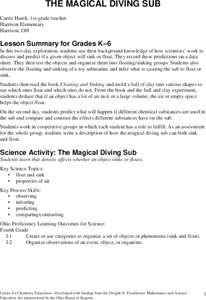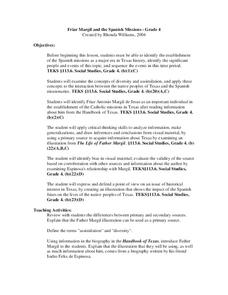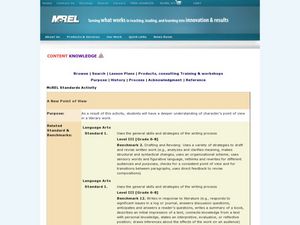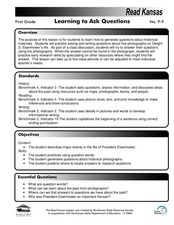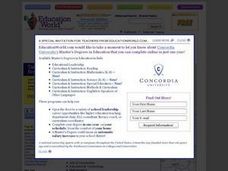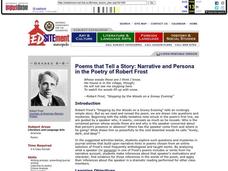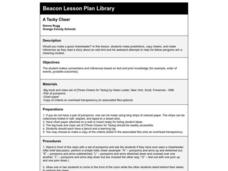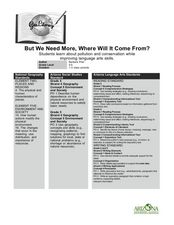Curated OER
The Magical Diving Sub
First graders discuss and predict if a given object sinks or floats. They record their predictions on a data sheet. Pupils test the objects and organize them into floating/sinking groups. Students observe the floating and sinking of a...
Curated OER
Friar Margil & The Spanish Missions
Students explore the life of Friar Margil de Jesus as well as other Spanish friars. They research Friar Margil and write a paragraph explaining why Spanish friars came to Texas. In groups, students create a PowerPoint presentation...
Curated OER
Friar Margil and the Spanish Missions
Fourth graders investigate the life of Friar Margil. In this research lesson, 4th graders analyze an illustration of Friar Margil, then create their own illustration of Friar Margil's life. A list of 5 materials is included.
Curated OER
Analyzing Literary Devices
Eighth graders identify figurative language and poetry in this literary analysis lesson. Using Through the Looking Glass by Lewis Carroll and a YouTube video for "The Walrus and the Carpenter," young readers complete a literary device...
Curated OER
A New Point of View
Analyze point of view and how it affects a literary work with this lesson. Middle schoolers create a written piece that focuses on point of view. They review the literary term "point of view," and explore examples of the term in text....
Curated OER
Sequence, Predict, Infer: Pink and Say
Practice sequencing with your 2nd graders via Patricia Polacco's Civil War book Pink and Say. Begin with a blindfold and a bag of mystery items. Connect their use of clues to identify what they can't see with the skill of making...
Curated OER
Checking Sources For Accuracy
Middle schoolers will paraphrase a resource without plagiarizing. Then rewrite after reading text. They then evaluate the site or reference they are using for accuracy. In the end, they complete a note-taking organizer.
Curated OER
Learning to Ask Questions
First graders analyze historical materials and create questions about Dwight D. Eisenhower. In this question writing instructional activity, 1st graders ask and answer questions about the life of Eisenhower. Students write about...
Curated OER
Schedules & Technology
Learn more about technology through matching, dictation, and word identification. English learners will participate in a variety of activities as they learn more about technology.
Curated OER
Word Roots 2: Fin, Sed, Fer Intermediate-Word Search
Make learning Latin roots a game! After you have introduced the roots fin, sed, and fer, learners can use this word search to build their vocabulary. (Within the word search are words containing these roots.) You can further the activity...
Curated OER
Note-Taking: K.I.S.S. "Keep It Short and Simple"
Note-taking is an essential study skill, and it needs to be taught! In the context of a research project on energy sources, learners find multiple sources, evaluating, paraphrasing, and citing them correctly. Two lists with note-taking...
Houghton Mifflin Harcourt
Voyagers: Extra Support Lessons (Theme 5)
This packet, the third in the series of support materials for the Houghton Mifflin Harcourt thematic units on voyagers, contains activities for learners who may struggle with the basic concepts of the lessons. Included are...
Channel Islands Film
Once Upon a Time (Saxipak’a): Lesson Plan 4
How did the environment and natural resources found on the Channel islands influence the culture of the Chumash? Archaeology meets technology in an activity designed for middle schoolers. After viewing West of The West's documentary Once...
National Endowment for the Humanities
Faulkner's As I Lay Dying: Burying Addie's Voice
Students explore the use of voice and title in William Faulkner's, "As I Lay Dying". They identify and discuss the use of image, symbols and narrative voice in the story.
Curated OER
What Can We Learn about India from a Ten Rupee Bank Note?
The class finds and cites evidence showing India's unity in diversity and work to recognize some of the complex interactions of a civilized community. They read to understand how geography, history, politics, economics,...
Curated OER
Nuts for Peanuts: Peanut Plants, Peanut Timeline, and Peanut-s-timation!
Students complete a timeline. In this peanuts lesson, students read A Short Peanut History and use this resource to make a timeline of the history of the peanut. Students can grow peanuts in the classroom or make various peanut recipes.
Curated OER
Medical Explorer
After reading a case study, pupils will explore possible diagnoses, assessment, and treatment plans. Finding the definitions to medical vocabulary and sorting through patient history, they will begin to understand the process of...
Curated OER
Poems that Tell a Story: Narrative and Persona in the Poetry of Robert Frost
Middle schoolers read and discuss poems by Robert Frost. Students collaborate in small groups to draw inferences about speakers' character and motives and to gather evidence supporting those inferences.
Curated OER
A Tacky Cheer
Second graders make predictions, copy cheers, and make inferences as they read a story about an odd bird and his awkward attempts to help his fellow penguins win a cheering contest.
Pennsylvania Department of Education
The Letter B (b)
Students discover words through text, audio and images that begin with the letter B. In this letter B lesson, students download an ebook and navigate through an interactive reading activity.
Curated OER
Literature-based Skill Building: Holes by Louis Sachar
In this reading skills learning exercise, students complete several literature-based skill building activities for the book 'Holes' by Louis Sachar.
Curated OER
Reading Strategies for Elementary Students
Students practice using strategies to help them read. They participate in activities that help them sound out words and determining the main idea. They also examine good and bad reading habits.
Curated OER
Literature Comprehension
In this reading comprehension instructional activity, students use the SADDR method to understand the literary tools used in a book. Students complete a speech analysis, action analysis, description analysis, drawing activity, reactions...
Curated OER
But We Need More, Where Will It Come From?
Students write a persuasive letter and create a poster about pollution and conservation. In this pollution and conservation lesson plan, students learn how humans are the number 1 cause of pollution.


